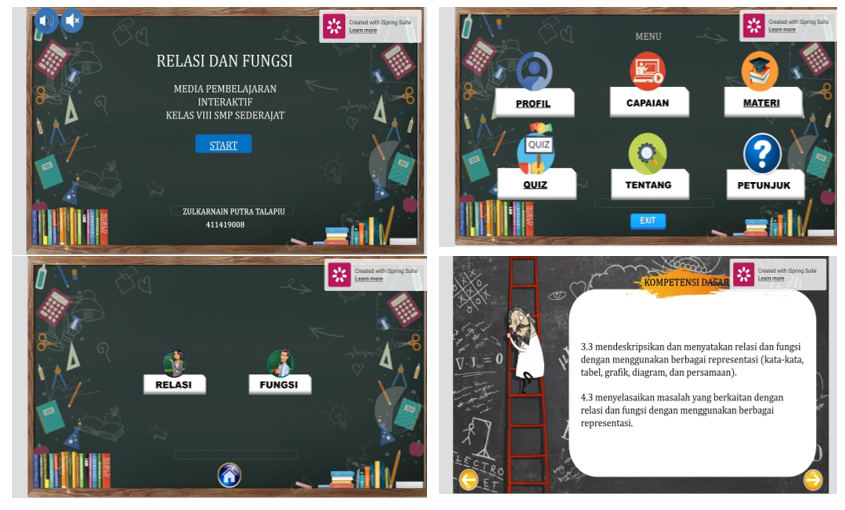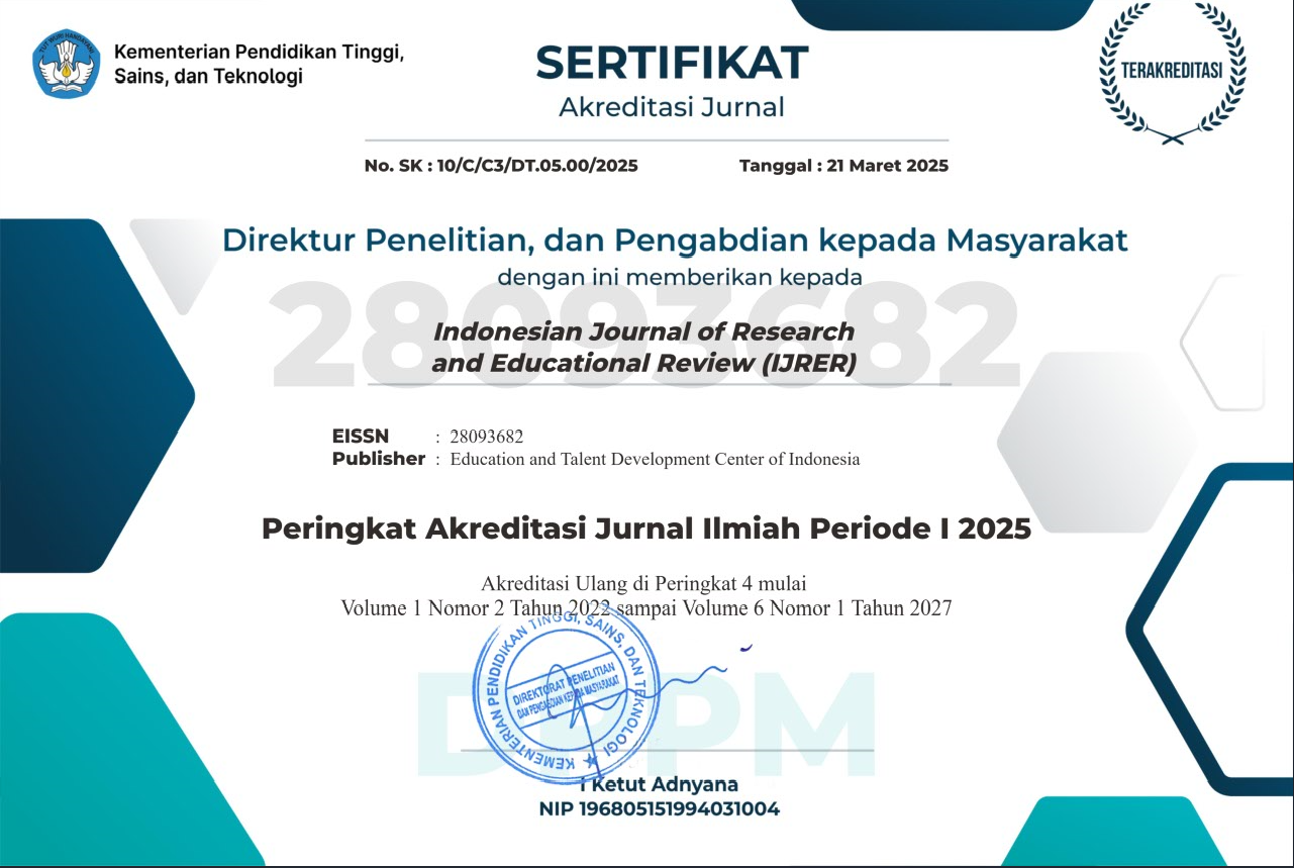Development of Interactive Learning Media on the Material of Relations and Functions in Middle School Students
https://doi.org/10.51574/ijrer.v4i2.2835
Keywords:
Interactive Learning Media, Middle School Students, Plomp, Relations and FunctionAbstract
This study intends to develop interactive learning media based on relationships and functions. The type of research used is development research that aims to produce a product. This study uses the Plomp development model. The sample of this study was eighth-grade students at Public Middle School 1 Bonepantai. The media development instruments in this study were validation sheets for media experts, validation sheets for material experts, and response questionnaire sheets for students and teachers. Data analysis uses quantitative descriptive analysis. The results of the study indicated that validation from media experts and material experts showed that the media met the criteria for being worthy of being tested. In addition, the results of the student response questionnaire on the interactive learning media developed were also positive; this can be seen from the average percentage of the student response questionnaire, which reached 90% with an excellent category, and the results of the teacher response questionnaire reached 91% with an excellent category. Therefore, interactive learning media meets practicality and learning merit criteria.
References
Akugizibwe, E., & Ahn, J. Y. (2020). Perspectives for effective integration of e-learning tools in university mathematics instruction for developing countries. Education and Information Technologies, 25(2), 889-903.
Aryanti, R. (2021). Development of interactive multimedia using Powerpoint applications combined with Ispring Suite application. In Sixth Padang International Conference On Economics Education, Economics, Business and Management, Accounting and Entrepreneurship (PICEEBA 2020) (pp. 325-330). Atlantis Press.
Attard, C., & Holmes, K. (2022). An exploration of teacher and student perceptions of blended learning in four secondary mathematics classrooms. Mathematics Education Research Journal, 34(4), 719-740.
Aziz, A., & Amidi, A. (2021). Development of android-based interactive learning media on statistics. Unnes Journal of Mathematics Education, 10(3), 244-250.
Baker, J. P., Goodboy, A. K., Bowman, N. D., & Wright, A. A. (2018). Does teaching with PowerPoint increase students' learning? A meta-analysis. Computers & Education, 126, 376-387.
Belbase, S., Mainali, B. R., Kasemsukpipat, W., Tairab, H., Gochoo, M., & Jarrah, A. (2022). At the dawn of science, technology, engineering, arts, and mathematics (STEAM) education: prospects, priorities, processes, and problems. International Journal of Mathematical Education in Science and Technology, 53(11), 2919-2955.
Bishop, A. (2020). Values in mathematics education. In Encyclopedia of mathematics education (pp. 893-896). Cham: Springer International Publishing.
Borba, M. C. (2021). The future of mathematics education since COVID-19: Humans-with-media or humans-with-non-living-things. Educational Studies in Mathematics, 108(1), 385-400.
Castro-Alonso, J. C., de Koning, B. B., Fiorella, L., & Paas, F. (2021). Five strategies for optimizing instructional materials: Instructor-and learner-managed cognitive load. Educational Psychology Review, 33(4), 1379-1407.
Chiu, T. K., & Mok, I. A. (2017). Learner expertise and mathematics different order thinking skills in multimedia learning. Computers & Education, 107, 147-164.
Chou, P. N., Chang, C. C., & Lu, P. F. (2015). Prezi versus PowerPoint: The effects of varied digital presentation tools on students’ learning performance. Computers & Education, 91, 73-82.
Clark, D. (2002). Psychological myths in e-learning. Medical teacher, 24(6), 598-604.
del Cerro Velázquez, F., & Morales Méndez, G. (2021). Application in augmented reality for learning mathematical functions: A study for the development of spatial intelligence in secondary education students. Mathematics, 9(4), 369.
Fitriani, N., & Leton, S. I. (2024). Utilizing e-comic media for differentiated learning: A realistic mathematics education approach to stimulate learning interest. Journal of Honai Math, 7(1), 71-90.
Ghanizadeh, A. (2017). The interplay between reflective thinking, critical thinking, self-monitoring, and academic achievement in higher education. Higher Education, 74, 101-114.
Hart-Davis, G., & Hart-Davis, G. (2017). Planning Your Raspberry Pi Classroom Deployment. Deploying Raspberry Pi in the Classroom, 1-16.Haryana, M. R. A., Warsono, S., Achjari, D., & Nahartyo, E. (2022). Virtual reality learning media with innovative learning materials to enhance individual learning outcomes based on cognitive load theory. The International Journal of Management Education, 20(3), 100657.
Hatisaru, V., & Erbas, A. K. (2017). Mathematical knowledge for teaching the function concept and student learning outcomes. International Journal of Science and Mathematics Education, 15, 703-722.
Hillman, S., Pang, C., Zamani, M., & Hillman, A. (2019). Designing Mobile Presentation Apps for North American K-12 Teachers. In Companion Publication of the 2019 on Designing Interactive Systems Conference 2019 Companion (pp. 201-205).
Hung, Y. H., Chen, C. H., & Huang, S. W. (2017). Applying augmented reality to enhance learning: a study of different teaching materials. Journal of Computer Assisted Learning, 33(3), 252-266.
Kioupi, V., & Voulvoulis, N. (2019). Education for sustainable development: A systemic framework for connecting the SDGs to educational outcomes. Sustainability, 11(21), 6104.
Kobandaha, P. E., Tonra, W. S., & Anam, A. C. (2022). Development of Digital Media and Ludo Eksponen to Improve Learning Outcomes of Grade IX Junior High School Students. Alifmatika: Jurnal Pendidikan Dan Pembelajaran Matematika, 4(1), 99-108.
Laswadi, L., Supriadi, N., Khaidir, C., & Anggoro, B. S. (2022). Investigating the effectiveness of using various mathematics learning media among students with various learning styles. Al-Jabar: Jurnal Pendidikan Matematika, 13(1), 189-198.
Lawrence, J. E., & Tar, U. A. (2018). Factors that influence teachers’ adoption and integration of ICT in teaching/learning process. Educational Media International, 55(1), 79-105.
Li, S., Yamaguchi, S., & Takada, J. I. (2018). The influence of interactive learning materials on self-regulated learning and learning satisfaction of primary school teachers in Mongolia. Sustainability, 10(4), 1093.
Mahendra, M. R. (2021). Development of Macromedia Flash-Based Mathematics Learning for Elementary School Students. In Journal of Physics: Conference Series (Vol. 1783, No. 1, p. 012006). IOP Publishing.
Masran, S. H., Marian, M. F., Yunus, F. A. N., Rahim, M. B., & Abd Baser, J. (2017). Effectiveness of using an interactive media in teaching and learning: A case study. In 2017 IEEE 9th International Conference on Engineering Education (ICEED) (pp. 222-227). IEEE.
Mensah, J. Y., & Nabie, M. J. (2021). The Effect of PowerPoint Instruction on High School Students' Achievement and Motivation to Learn Geometry. International Journal of Technology in Education, 4(3), 331-350.
Muhaimin, L. H., & Juandi, D. (2023). The role of learning media in learning mathematics: a systematic literature review. Journal of Mathematics and Mathematics Education, 13(1), 85-107.
Muhammad, I., Mukhibin, A., do muhamad Naser, A., & Dasari, D. (2022). Bibliometric analysis: Research trend of interactive learning media in mathematics learning in Indonesia. Prisma Sains: Jurnal Pengkajian Ilmu Dan Pembelajaran Matematika Dan IPA IKIP Mataram, 11(1), 10-22.
Nurfalah, E., Yuliastuti, R., Rahayu, P., & Sulistyaningrum, H. (2021). Assessing the effectiveness of using digital mathematics technology on student mathematics learning. In Journal of Physics: Conference Series (Vol. 1776, No. 1, p. 012008). IOP Publishing.
Plomp, T. (2013). Educational design research: An introduction. Educational design research, 1, 11-50.
Ou, S., & Ou, X. (2024). Effects of Blackboard Teaching and PPT Teaching in High School Mathematics Classroom Based on Cognitive Load Theory. Open Access Library Journal, 11(12), 1-20.
Ramlah, R., Riana, N., & Abadi, A. P. (2022). Fun math learning for elementary school students through interactive puzzle media. SJME (Supremum Journal of Mathematics Education), 6(1), 25-34.
Rittle‐Johnson, B. (2017). Developing mathematics knowledge. Child Development Perspectives, 11(3), 184-190.
Rozi, F., & Kristari, A. (2020). Pengembangan Media Pembelajaran Game Edukasi Berbasis Android Pada Mata Pelajaran Fisika Untuk Siswa Kelas Xi Di Sman 1 Tulungagung. JIPI (Jurnal Ilmiah Penelitian dan Pembelajaran Informatika), 5(1), 35-44.
Sawhney, R., Pradhan, N., Matias, N., De Anda, E. M., Araujo, E., Trevino, S., & Arbogast, C. (2019). Teaching sustainable lean: the next step towards inculcating a critical problem-solving mindset. Lean Engineering for Global Development, 61-94.
Senanayake, J., Kalutarage, H., & Al-Kadri, M. O. (2021). Android mobile malware detection using machine learning: A systematic review. Electronics, 10(13), 1606.
Siregar, A. S. B., Tobing, E. G. L., & Fitri, N. R. (2021). Developing of teaching materials: using animation media to learning english vocabulary for early childhood. ETDC: Indonesian Journal of Research and Educational Review, 1(1), 9-16.
Siswanto, D. H., & Peni, N. R. N. (2023). Publication Trend on the Plomp Development Model in Mathematics Education. Asian Pendidikan, 3(2), 71-80.
Sowder, J. T. (2020). Making sense of numbers in school mathematics. In Analysis of arithmetic for mathematics teaching (pp. 1-51). Routledge.
Sugiyono. 2017. Metode Penelitian Kuantitatif, Kualitatif Dan R & D. Bandung: Alfabeta
Vos, P. (2018). “How real people really need mathematics in the real world”—Authenticity in mathematics education. Education Sciences, 8(4), 195.
Wang, S. K., Hsu, H. Y., Reeves, T. C., & Coster, D. C. (2014). Professional development to enhance teachers' practices in using information and communication technologies (ICTs) as cognitive tools: Lessons learned from a design-based research study. Computers & Education, 79, 101-115.
Ziatdinov, R., & Valles Jr, J. R. (2022). Synthesis of modeling, visualization, and programming in GeoGebra as an effective approach for teaching and learning STEM topics. Mathematics, 10(3), 398.

Downloads
Published
How to Cite
Issue
Section
License
Copyright (c) 2025 Zulkarnain Putra Talapiu, Nurhayati Abbas, Nancy Katili

This work is licensed under a Creative Commons Attribution-ShareAlike 4.0 International License.

























